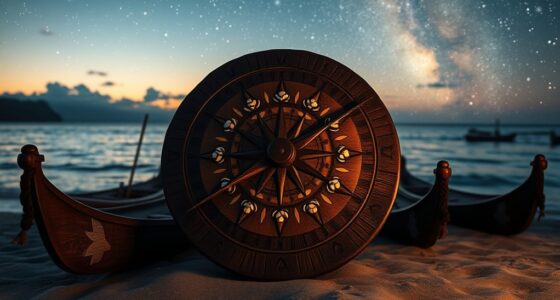Deciphering Rongorongo is a major challenge because the script remains largely a mystery. Scholars haven’t found definitive clues about its sounds, meanings, or how it was used. Its glyphs are arranged without a clear pattern, making interpretation difficult. Researchers compare it with Polynesian languages, but no consensus has been reached. If you’re curious about what makes this script so puzzling, keep exploring — the story behind Rongorongo is full of secrets waiting to be uncovered.
Key Takeaways
- Rongorongo remains undeciphered due to lack of bilingual texts and unclear glyph meanings.
- Its complex arrangement suggests possible encoding of chants, genealogies, or astronomical data.
- Cultural context and Polynesian linguistic comparisons offer insights but no definitive decipherment.
- No consensus exists on reading order or whether glyphs represent sounds, symbols, or mnemonics.
- Future breakthroughs depend on discovering new artifacts or advanced linguistic and cultural research.

Deciphering Rongorongo remains one of the greatest puzzles in the study of Polynesian history. You’re faced with a script that defies easy understanding, a set of glyphs that have stumped scholars for centuries. These hieroglyphic puzzles aren’t just symbols etched into wood; they’re keys to a lost culture’s knowledge, beliefs, and stories. Yet, despite numerous efforts, the linguistic mysteries surrounding Rongorongo continue to dominate archaeological and linguistic circles. You might wonder why this script remains so elusive. The answer lies in its uniqueness and the scarcity of contextual clues. Unlike other ancient scripts, Rongorongo lacks a confirmed decipherment, and no bilingual inscriptions have emerged to guide interpretation. This absence makes it incredibly difficult to establish correlations between glyphs and language sounds or meanings.
As you explore the world of Rongorongo, you realize that understanding its structure might be the first step. The glyphs are arranged in lines, often read from left to right or right to left, but there’s no universal agreement on a standard reading order. Some believe the glyphs encode chants, genealogies, or astronomical data, while others think they serve a ritualistic purpose. The diverse theories reflect the script’s cryptic nature, deepening your frustration yet fueling your curiosity. You begin to see that deciphering Rongorongo isn’t just about translating symbols; it’s about unraveling a complex system of communication that’s intertwined with the island’s culture. Cultural context plays a crucial role in understanding its potential meanings.
Research efforts have primarily focused on comparing Rongorongo with other Polynesian languages and scripts, but so far, these comparisons haven’t yielded definitive results. Many scholars suspect that Rongorongo might be an incomplete or symbolic system, or perhaps a form of mnemonic device rather than a fully developed writing system. This uncertainty adds to the linguistic mysteries that make the script so intriguing. You’re left pondering whether Rongorongo represents a lost form of Polynesian literacy or a cultural relic with no direct linguistic equivalent. The challenge lies in bridging the gap between the glyphs and their original meaning, a task that demands both linguistic insight and cultural understanding. Until new discoveries surface—be they inscriptions, artifacts, or breakthroughs in comparative linguistics—the script remains an enigma, a tribute to the rich but inaccessible history of Easter Island.
Frequently Asked Questions
Are There Any Living Experts Who Can Read Rongorongo?
You wonder if any living experts can read rongorongo. While some linguists and archaeologists have ongoing decipherment efforts, no one has conclusively decoded the script yet. Their linguistic expertise helps analyze symbols, but rongorongo remains largely unreadable. Despite advancements, the script’s meaning is still a mystery, so you won’t find anyone who can fully interpret it today. It’s an intriguing puzzle that continues to challenge researchers worldwide.
How Many Rongorongo Tablets Still Exist Today?
You might wonder how many rongorongo tablets remain, considering preservation challenges and ongoing scholarly debates. Today, about two dozen tablets are known to exist, scattered across museums and private collections worldwide. Despite efforts to protect these artifacts, their fragile nature makes preservation difficult. These remaining pieces hold the key to understanding Easter Island’s past, yet much about them remains shrouded in mystery, fueling debates among researchers aiming to unseal their secrets.
Was Rongorongo Used for Everyday Communication or Only Ceremonial?
You might wonder if rongorongo was used in daily life or just for ceremonial purposes. Evidence suggests it was primarily for special occasions or rituals, not everyday communication. The intricate carvings likely held cultural or spiritual significance, making them reserved for ceremonial use. While some scholars debate its exact purpose, it’s clear rongorongo played an important role in Easter Island’s ceremonial practices rather than regular daily interactions.
What Materials Were Used to Carve the Rongorongo Tablets?
Think of rongorongo tablets as ancient stone canvases. You learn that they were carved from wood, mainly lightweight logs from local trees, chosen for their availability and workability. The carving techniques involved sharp tools to etch the symbols into the material’s surface, considering material durability to guarantee the carvings lasted. You realize that their preservation depended on selecting the right wood and employing careful carving methods to withstand time’s wear.
Could Rongorongo Be Related to Other Polynesian Scripts?
You might wonder if Rongorongo relates to other Polynesian scripts. Based on comparative Polynesian linguistics, there’s little evidence of direct connections to ancient scripts from nearby islands. While some scholars suggest possible ancient script connections, most agree Rongorongo appears unique. Its symbols don’t align with known Polynesian writing systems, indicating it might be an isolated development rather than part of a broader network of ancient Polynesian scripts.
Conclusion
You’ve learned that Rongorongo remains one of the world’s few undeciphered scripts, with over 600 glyphs found on Easter Island. Fascinatingly, only about 20% of these glyphs are consistently understood, leaving most a mystery. This lingering enigma sparks curiosity and invites further exploration. As researchers continue decoding, you can’t help but wonder what stories and secrets are hidden within those ancient symbols, waiting to finally reveal Easter Island’s rich history.










